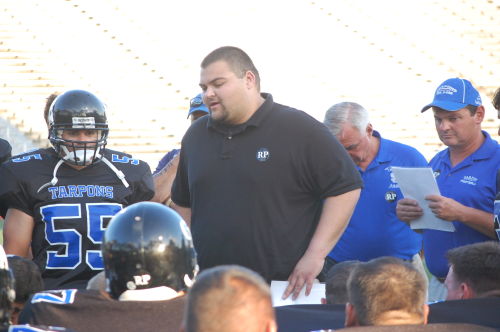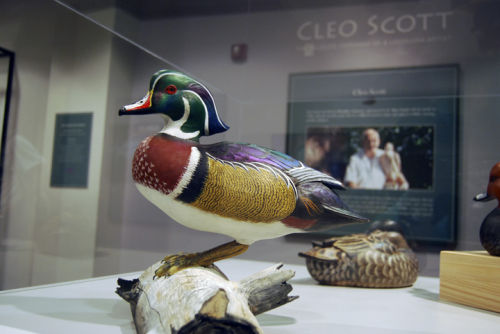
BREAKING: Coach, girlfriend, 3 others given criminal summons after Destrehan forfeitures
October 30, 2013
‘Ghost the Musical’ blowing into Saenger
October 31, 2013Cleo Scott is from a bygone time, though he’s a steward of that era as one of a few remaining sculptors of wooden wildlife.
For instance, his arrival in Morgan City was via a home-built camp boat, powered by a 4-horsepower, single-cylinder engine and navigated through the Red, Mississippi and Atchafalaya rivers when Scott was 5 years old.
“My dad built a camp boat on side the levee there in Alexandria and finished it,” said Scott, who was actually born in Memphis. “It was a wild trip. … I can remember the water being so swift. Stopping at night, we would tie up at night. It was just like a house. You had everything you needed on that camp boat.”
Seventy-five years after that journey, Scott’s artwork has a one-year residence at the Louisiana State Museum in Patterson, a location at the head of scenic Kemper Williams Park and just close enough to a rail-line that a train’s horn occasionally echoes off the walls surrounding his wood-carved wildlife sculptures. Nostalgia and nature are intertwined.
“I think it (Scott’s artwork) offers a good representation, for the average visitor that comes to Patterson, about a very prominent folk tradition of south Louisiana,” said Polly Rolman-Smith, curator of science and technology with the state museum. “Duck decoy carving has been a long tradition in south Louisiana, especially amongst Cajun duck hunters.”
South Louisiana has been Scott’s home for three-quarters of a century. He dropped out of Morgan City High School at 15 years old, moving to New Orleans in hopes of becoming a boxer. At 17 years old, he was a participant in the Korean War.
Not long after he returned to the U.S., Scott began working for Halliburton. After that he spent 17 years with state police, retiring and then joining the St. Mary Parish Sheriff’s Office. He also worked as a nuisance alligator hunter for the Department of Wildlife and Fisheries. Throughout his life, Scott hunted, fished and generally enjoyed nature, he said.
Now, for balance, Scott utilizes a wooden cane he carved. He fell out of a tree four years ago, shattering both his ankles and wrenching his back. At 80 years old and with a limp, it may take him a little more time than it once did to get from one point to another, but he maintains an active spirit, typically juggling three-to-four artistic projects among his household chores.
Retirement is not a synonym for recline, he admits, though it has provided him the chance to dive headfirst into sculpting, which he seamlessly picked up 17 years ago.
“I was in Branson, Mo., and I seen an old boy carving some boots. I watched him for a while and figured, ‘I can do that, too.’ That’s what started me.”
Not long after he began producing wooden birds, Scott learned of Carl Danos, a prominent member of the carving community. He took classes under Danos’ tutelage, and he still meets with a loyal group of carvers on a weekly basis. They practice art, drink coffee and “shoot the bull,” he said.
Scott and the other carvers who persist don’t craft their pieces for hunting. Instead, their creations serve to woo viewers and celebrate the process, which simultaneously quenches an artist’s desire to be in-tune with nature. The amount of carving inspired by utility is negligible, considering retailers like Cabella’s offer field-appropriate duck decoys at less than $50.
As went the utility of carving, so did the motivation to carve.
“It’s just a dying art,” Scott said. “Nobody wants to take the time to do it, I don’t guess. I really don’t know (why), because it’s so satisfying to know that you can sit down and be able to carve something out of a piece of wood and make it look realistic.”
Scott is more inclined to discuss his biographical information and carving process, concrete details, rather than deal in the abstract with subjects like the modern-day significance of wildlife carving. This mindset directly correlates to the craft, which still values authenticity over everything else.
A frequent competitor in Houma and Larose competitions, Scott understands that judges examine a product’s buoyancy, color and ridges. Some of his creations are slick, which means the definition is done by paint, but most of his products get their vein protrusions and hairlines from the tip of his knife. Authenticity in color is no less important.
“You can carve a good bird; if you can’t paint, you might as well throw it away. Your painting is 75-or-more percentage of (the value),” he said. “It’s trying to make it more realistic than anything. The eyes, I think, are a key to it. When you walk around that bird, you want to see that the eyes are following you, just like a real good portrait artist does.”
Scott’s birds get the most play in his exhibit, but there are a few other items, such as a turtle and a flower, both of which could easily pass for natural creations in another setting. And there’s seemingly no limit to his ambition. “The last animal I carved was a camel,” he said as if he views it as a satisfied challenge. “If you’ve got the money, I’ll carve anything.”
Wildlife carvings fetch big money, locally and abroad. Scott estimates that most “highly decorative” creations range from $800 to $1,200 in value. A red-tailed hawk, part of the Patterson exhibit’s centerpiece and one of his latest products, could be worth as much as $5,000 at an auction, he estimated.
Money, however, isn’t what drove him to start. It was a competitive spirit mixed with a curiosity of what he could create from an inflexible medium.
“I just love to see it come out of the wood,” he said. “It’s amazing what you can do with a piece of wood and a knife.”
The exhibit “Cleo Scott: The Wildlife Carvings of a Louisiana Artist” is open Tuesday through Sunday through August 2014 at Louisiana State Museum-Patterson, 118 Cotten Road. Admission is free. For more information, call (985) 399-1268.
Cleo Scott’s wildlife carvings are on exhibit at the Louisiana State Museum in Patterson through August 2014. Most of the detailing, including hairlines, is done with a knife.
Scott is flanked by his wood-carved creations. At left is his red-tailed hawk, which he estimates could fetch $5,000.










